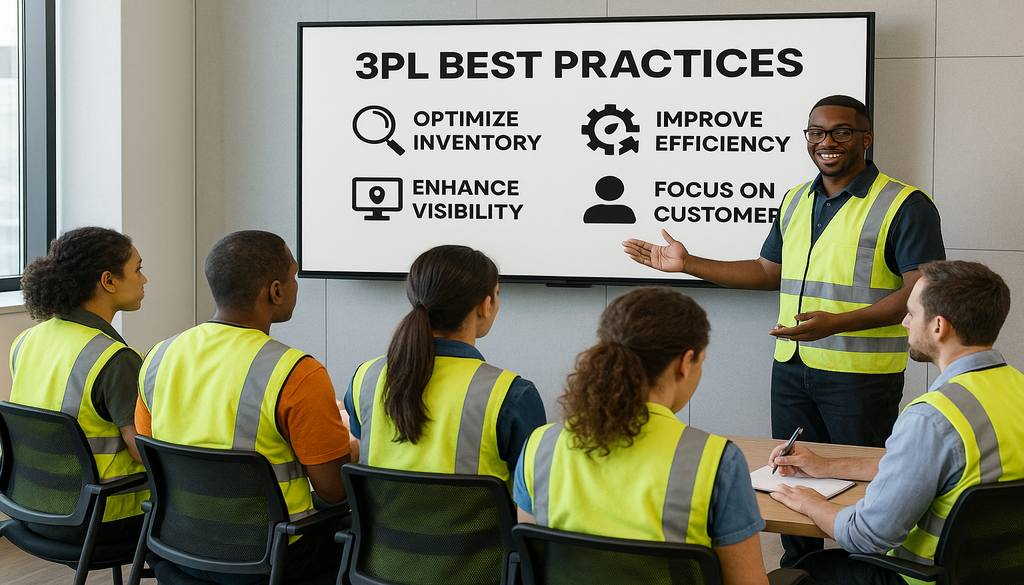Understanding the Role of 3PL Software in Modern Logistics
In today’s fast-paced logistics environment, third-party logistics (3PL) software plays a pivotal role in streamlining operations and enhancing efficiency. These systems offer a suite of functionalities designed to manage everything from inventory control to order processing and transportation management. The importance of 3PL software in supply chain management cannot be overstated, as it provides the technological backbone that supports seamless integration across various logistics functions. By leveraging these tools, logistics companies can achieve greater accuracy, reduce operational costs, and improve customer satisfaction, ultimately driving business growth.
Tip 1: Automating Routine Tasks
Automation is a game-changer in the logistics industry, particularly for 3PL operations. By automating routine tasks such as order entry, inventory updates, and shipment tracking, companies can significantly reduce the time and effort required for manual processes. This not only frees up valuable human resources for more strategic activities but also minimizes the risk of errors that can occur with manual data entry. For instance, using automated systems to manage inventory levels ensures that stock is replenished just in time, reducing the likelihood of overstocking or stockouts. The benefits of automation extend beyond time savings; they also enhance accuracy and reliability, leading to improved service delivery and customer satisfaction.
Tip 2: Integrating 3PL Tools with Existing Systems
System integration is a critical aspect of maximizing the potential of 3PL software. However, it often presents challenges such as compatibility issues and data silos. To overcome these hurdles, companies should focus on selecting 3PL tools that offer robust integration capabilities with existing enterprise resource planning (ERP) systems and other software applications. Seamless integration facilitates smooth data flow across different platforms, enabling real-time visibility into operations and informed decision-making. For example, integrating 3PL software with a customer relationship management (CRM) system can enhance customer service by providing sales teams with up-to-date information on order status and inventory levels.
Tip 3: Leveraging Data Analytics for Better Decision Making
In the age of big data, leveraging analytics is crucial for gaining insights into logistics operations. 3PL software can track and analyze various types of data, including delivery times, inventory turnover rates, and customer feedback. By interpreting this data, logistics managers can identify trends, forecast demand, and optimize supply chain processes. For instance, analyzing delivery performance data can help pinpoint bottlenecks in the distribution network, allowing for targeted improvements. Additionally, data-driven insights can enhance customer satisfaction by enabling more accurate delivery estimates and personalized service offerings.
Tip 4: Enhancing Inventory Visibility and Control
Effective inventory management is a cornerstone of successful 3PL operations. Techniques such as real-time tracking and automated inventory alerts can significantly enhance visibility and control over stock levels. Enhanced visibility allows logistics providers to respond swiftly to changes in demand, reducing the risk of stockouts and overstocking. This not only improves service levels but also helps control costs by minimizing excess inventory and associated holding costs. Implementing advanced inventory management systems can also facilitate more accurate demand forecasting, enabling better planning and resource allocation.
Tip 5: Streamlining Returns Management
Returns management is a complex yet essential component of logistics operations. Efficient handling of returns can greatly impact customer satisfaction and operational efficiency. Best practices for returns management include implementing a clear returns policy, using automated systems for tracking returns, and employing reverse logistics strategies to minimize costs. Tools such as barcode scanning and automated return authorization processes can simplify and speed up the returns process, ensuring a smooth experience for customers and reducing the administrative burden on staff.
Tip 6: Prioritizing Security and Compliance in 3PL Operations
Security and compliance are paramount in the logistics industry, where sensitive data and valuable goods are constantly in transit. Key security measures include implementing robust cybersecurity protocols, such as encryption and multi-factor authentication, to protect data integrity. Compliance challenges, such as adhering to industry regulations and standards, can be addressed by staying informed about regulatory changes and incorporating compliance checks into operational processes. Regular audits and staff training on security best practices are also essential for maintaining a secure and compliant logistics operation.
Tip 7: Training Staff on 3PL Best Practices
Investing in staff training is crucial for achieving operational excellence in 3PL operations. Well-trained employees are more efficient, make fewer errors, and are better equipped to handle the complexities of logistics management. Strategies for effective staff training include offering regular workshops, providing access to online learning resources, and fostering a culture of continuous improvement. Engaging staff in training programs not only enhances their skills but also boosts morale and job satisfaction, leading to improved performance and reduced turnover.
Tip 8: Regularly Updating and Maintaining 3PL Software
Keeping 3PL software up-to-date is essential for maintaining security and efficiency. Regular updates ensure that the software is equipped with the latest features and security patches, protecting against vulnerabilities and enhancing performance. Best practices for maintaining software health include scheduling routine maintenance checks, monitoring system performance, and promptly addressing any issues that arise. By prioritizing software maintenance, logistics companies can avoid costly disruptions and ensure that their operations run smoothly.
Tip 9: Customizing Features to Fit Specific Needs
Customization is a powerful tool for tailoring 3PL software to meet the unique needs of a logistics operation. By customizing features such as reporting dashboards, workflow automation, and user interfaces, companies can optimize their software for specific operational requirements. For example, a logistics provider specializing in perishable goods might customize their software to include temperature monitoring and alerts. Customization not only enhances operational efficiency but also provides a competitive edge by enabling more personalized service offerings.
Tip 10: Evaluating and Selecting the Right 3PL Tools
Selecting the right 3PL tools is a critical decision that can impact the success of logistics operations. Key criteria for evaluating software options include functionality, scalability, ease of use, and vendor support. It’s important to assess how well the software aligns with business goals and operational needs. Additionally, evaluating vendor support services, such as training and technical assistance, can ensure a smooth implementation and ongoing success. By carefully selecting the right tools, logistics companies can enhance their operational capabilities and achieve long-term success.
Conclusion
This guide outlines ten actionable tips that can transform the way your 3PL operations function, leveraging 3PL software to its fullest potential. By implementing these strategies, you can achieve higher efficiency, better compliance, and improved customer satisfaction, ensuring your logistics operations are both resilient and responsive. Embrace these practices to stay competitive in the ever-evolving logistics landscape, and watch your business thrive.
Frequently Asked Questions (FAQ)
- What is 3PL software and how does it benefit logistics companies?
- 3PL software is a comprehensive tool designed to manage various logistics functions, including inventory management, order processing, and transportation. It benefits logistics companies by streamlining operations, reducing costs, and improving accuracy and customer satisfaction through enhanced visibility and control over logistics processes.
- How can automation in 3PL software improve productivity?
- Automation in 3PL software improves productivity by reducing the need for manual intervention in routine tasks, such as data entry and inventory updates. This leads to faster processing times, fewer errors, and allows staff to focus on more strategic activities, ultimately enhancing overall operational efficiency.
- What are some common challenges in integrating 3PL systems?
- Common challenges in integrating 3PL systems include compatibility issues with existing software, data silos, and the complexity of managing multiple platforms. Solutions involve selecting tools with robust integration capabilities, employing middleware for seamless data exchange, and ensuring comprehensive training for staff to manage integrated systems effectively.
- How often should 3PL software be updated?
- 3PL software should be updated regularly, ideally as soon as new updates are released. This ensures the software remains secure, incorporates the latest features, and performs optimally. Regular updates help protect against security vulnerabilities and enhance the overall functionality of the software.
- Can 3PL software be customized for any size of logistics company?
{
“@context”: “https://schema.org”,
“@type”: “FAQPage”,
“mainEntity”: [
{
“@type”: “Question”,
“name”: “What is 3PL software and how does it benefit logistics companies?”,
“acceptedAnswer”: {
“@type”: “Answer”,
“text”: “3PL software is a comprehensive tool designed to manage various logistics functions, including inventory management, order processing, and transportation. It benefits logistics companies by streamlining operations, reducing costs, and improving accuracy and customer satisfaction through enhanced visibility and control over logistics processes.”
}
},
{
“@type”: “Question”,
“name”: “How can automation in 3PL software improve productivity?”,
“acceptedAnswer”: {
“@type”: “Answer”,
“text”: “Automation in 3PL software improves productivity by reducing the need for manual intervention in routine tasks, such as data entry and inventory updates. This leads to faster processing times, fewer errors, and allows staff to focus on more strategic activities, ultimately enhancing overall operational efficiency.”
}
},
{
“@type”: “Question”,
“name”: “What are some common challenges in integrating 3PL systems?”,
“acceptedAnswer”: {
“@type”: “Answer”,
“text”: “Common challenges in integrating 3PL systems include compatibility issues with existing software, data silos, and the complexity of managing multiple platforms. Solutions involve selecting tools with robust integration capabilities, employing middleware for seamless data exchange, and ensuring comprehensive training for staff to manage integrated systems effectively.”
}
},
{
“@type”: “Question”,
“name”: “How often should 3PL software be updated?”,
“acceptedAnswer”: {
“@type”: “Answer”,
“text”: “3PL software should be updated regularly, ideally as soon as new updates are released. This ensures the software remains secure, incorporates the latest features, and performs optimally. Regular updates help protect against security vulnerabilities and enhance the overall functionality of the software.”
}
},
{
“@type”: “Question”,
“name”: “Can 3PL software be customized for any size of logistics company?”,
“acceptedAnswer”: {
“@type”: “Answer”,
“text”: “Yes, 3PL software can be customized to fit the needs of logistics companies of any size. Customization options allow businesses to tailor the software to their specific operational requirements, whether they are small enterprises or large corporations, ensuring scalability and flexibility to support growth and changing needs.”
}
}
]
}- Yes, 3PL software can be customized to fit the needs of logistics companies of any size. Customization options allow businesses to tailor the software to their specific operational requirements, whether they are small enterprises or large corporations, ensuring scalability and flexibility to support growth and changing needs.










